The Samsung Galaxy S7 and S7 edge Review: Part 2
by Joshua Ho on July 5, 2016 8:00 AM ESTCamera Architecture and UX
In general, camera has become probably the single biggest point of differentiation between smartphones at this point. As smartphones are often the only camera that most people carry on a day to day basis, the rear camera on a smartphone really cannot be a disappointment relative to the competition. While we can talk about how much a front-facing camera matters in terms of quality, it’s pretty safe to say that for photos and videos that are worth saving will be taken with the rear-facing camera.
While post-processing and a number of other factors are going to have a huge impact on the overall camera experience, the foundation that makes it possible to deliver a great camera is always going to start at the hardware.
| Samsung Galaxy S Cameras | ||||
| Galaxy S6 Galaxy Note5 |
Galaxy S7 | |||
| Front Camera | 5.0MP | 5.0MP | ||
| Front Camera - Sensor | Samsung S5K4E6 (1.34 µm, 1/4.1") |
Samsung S5K4E6 (1.34 µm, 1/4.1") |
||
| Front Camera - Focal Length | 2.2mm (22mm eff) | 2.1mm (21mm eff) | ||
| Front Camera - Max Aperture | F/1.9 | F/1.7 | ||
| Rear Camera | 16MP | 12MP | ||
| Rear Camera - Sensor | Sony IMX240 Samsung S5K2P2 (1.12 µm, 1/2.6") |
Sony IMX260 Samsung S5K2L1 (1.4 µm, 1/2.6") |
||
| Rear Camera - Focal Length | 4.3mm (28mm eff) | 4.2mm (26mm eff) | ||
| Rear Camera - Max Aperture | F/1.9 | F/1.7 | ||
In the case of the Galaxy S7, Samsung has done something that I thought they’d never do, which is move backwards in resolution in order to improve pixel sensitivity. In the case of the Galaxy S7, Samsung has moved from the Sony IMX240/Samsung S5K2P2 to the Sony IMX260/Samsung S5K2L1 sensor, with a 1.4 micron pixel size relative to a 1.12 micron pixel pitch in the previous generation. This means that there’s a 56% increase in sensitivity per pixel. Assuming the same process technology, this does improve low light performance significantly. While to some extent it’s true that improved CIS (CMOS image sensor) technology can alleviate the downsides of smaller pixels, on the same technology you have to reduce your fill factor/active sensor area. The other problem is that while read noise on the sensor does reduce per pixel as you reduce pixel size, the overall sensor read noise trends upwards. This means that the region in which the CIS noise is primarily limited by shot noise is going to be smaller as you reduce pixel size. Shot noise is an unavoidable reality of existence, to the extent that even our eyes can see this “visual snow” if ambient light is sufficiently dim.
However, in the case of the Galaxy S7 I suspect that there’s more to the story, because the dual pixel AF system means that for each 1.4 micron pixel each pixel needs two photodetectors. In order to make phase detection work, there has to be sufficient spatial separation to make this system work properly, so some of the benefit of these larger pixels will inevitably be eaten up in order to enable PDAF that works in basically all lighting conditions.
The other notable change here is that the Galaxy S7 uses an even wider f/1.7 aperture. Unfortunately, in Samsung's efforts to try and make the module thinner they've made the focal length slightly shorter than before which results in an effective focal length of 26mm. This and the wider aperture could lead to compromises as light is entering the optics at a more extreme angle than before.
With these basics covered, we can move on to a discussion of the user experience. While in the past it was easy enough to just take some still shots on a tripod, a holistic view of camera quality really needs to take into account far more than just the end result. A poorly designed camera application with low resolution, low frame rate preview, improper preview aspect ratio, poor control layout, and other issues can easily make it difficult, if not impossible to get the photo that you want. These issues are thankfully getting less common, but these problems can make it almost impossible to recommend a phone for its camera, no matter how good the results are.
In the case of the Galaxy S7, the camera application is a nice upgrade over the Galaxy S6 at launch, but for the most part nothing is really different this go around. I’m not going to spend too much time here, but the short story is that I don’t think that Samsung is doing anything wrong here, and things are pretty much as good as they’re going to get.
While leaving it at that would be enough, I want to recognize some of the improvements that Samsung has implemented here. The major improvement here is that Pro mode is finally useful, as this mode now allows for adjusting auto-exposure and AF targets, in addition to EV, shutter speed, ISO, white balance with 100K granularity, and manual focus. The one notable shortfall here is that Samsung only allows 800 ISO max in manual ISO mode when the true maximum is 1250. For better or worse though, that’s the only notable problem I encountered with the camera app itself. It’s easy to think that Samsung hasn’t done anything notable here, but this is more a testament to the execution of design more than anything else.
However, before we move on to image quality testing, we can take a look at our focus and capture latency tests. For those that are unfamiliar, this is a fairly simple test designed to see how long it takes for a phone to focus and capture a scene on our standard ISO test chart in good lighting conditions, which can give a fairly good idea for best case latencies.
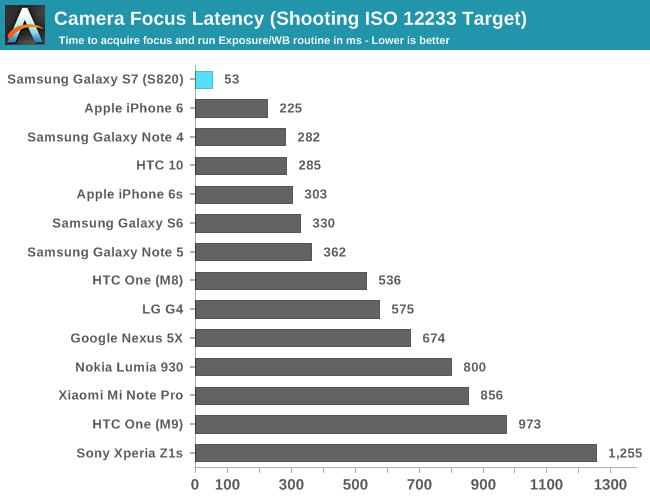
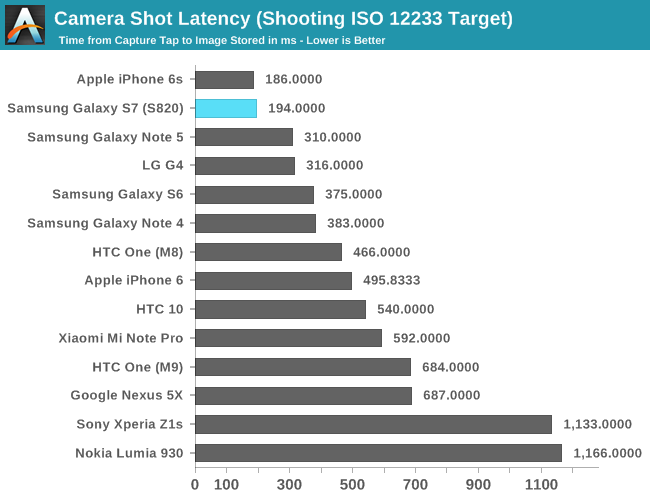
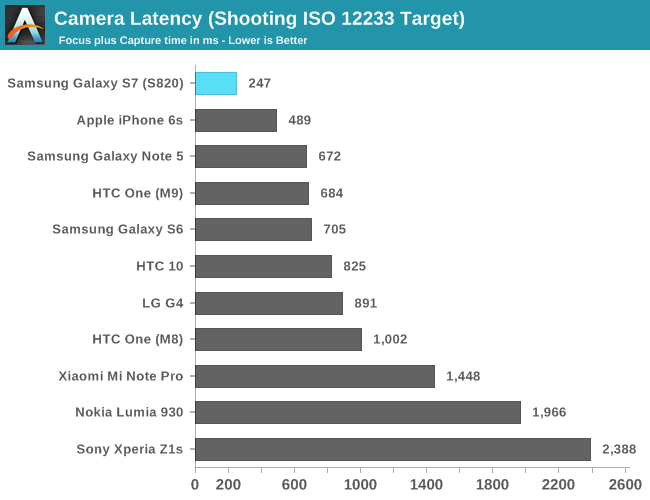
It’s probably not a surprise, but the Galaxy S7 is really, absurdly quick to take photos and focus. There is nothing out there that can realistically match the dual pixel AF system in the Galaxy S7, especially once you get into low light scenarios where traditional PDAF systems are overwhelmed by noise that can’t be easily canceled out. Samsung’s sheer prowess in semiconductor design and manufacture is really showing here, even in the best case.


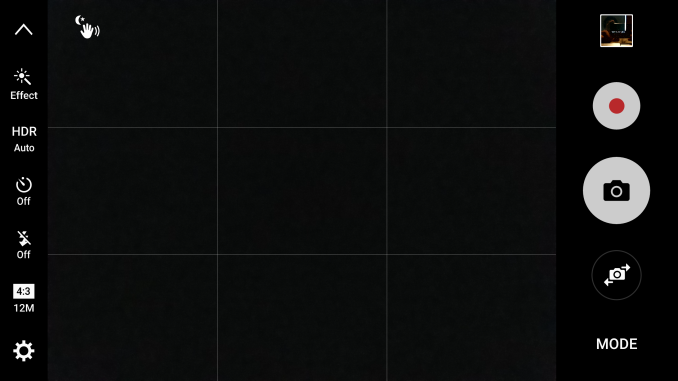
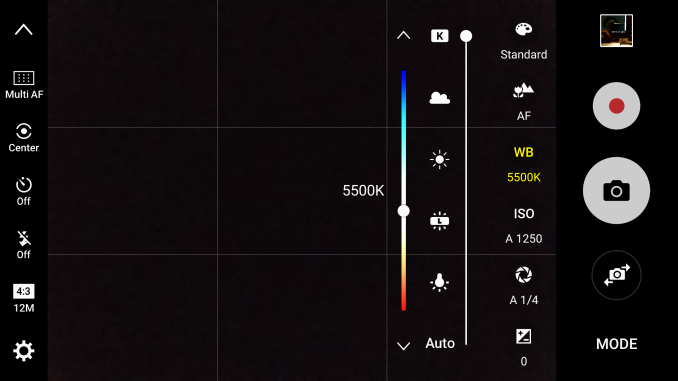
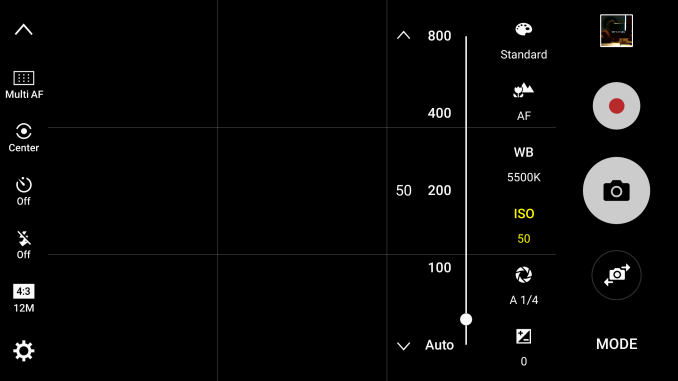








266 Comments
View All Comments
retrospooty - Wednesday, July 6, 2016 - link
Close... I wish Anandtech would get back to the "tech" part. It used to be about tech and now as you even agree, its about clicks and paying the bills.BurntMyBacon - Wednesday, July 6, 2016 - link
@dsumanik: "heres proof:http://www.ibtimes.com/apples-ios-still-getting-cr...
I kinda see what you're getting at here, but these numbers are from October of last year. Though, I couldn't help but note that according to these numbers, Windows is actually persisting in most markets. The numbers aren't great, but enough to be a significant presence. Even the U.S. is 3.5%. I thought we were seeing articles around this time period about how the Windows market share was sub-1%, insignificant, and dead to rights. Question is, are we sure these numbers are accurate? Or is it that tech review websites are preaching Windows doom and gloom to generate clicks? I suppose the second option would fit the mold that M2K is suggesting.
Byte - Tuesday, July 5, 2016 - link
Apple rules the mobile roost right now. Just look at the sales, app ecosystem, users. Why aren't you crying that Apple has all of that? Don't even get started at tablets, there isn't even any contest. One day though, maybe soon, it will come crashing down, just like what happened to Blackberry, what will you cry about then?Geranium - Wednesday, July 6, 2016 - link
Apple's CPU performs better running Apple optimized benchmark.jlabelle2 - Wednesday, July 6, 2016 - link
- There is something wrong with you if you think of people as with you and against you -I think it is pretty clear that the editorial line has changed since departure of Anand (...to Apple "cough").
For instance, when speaking of the camera, there is a mention that the resolution of the 12Mp S7 is not better than the 12Mp iPhone 6S (strange?) but when speaking of low light, as the iPhone is not anymore a contender (as the images show), then we mode the reference to LG or HTC. And this is constant all around Apple products review just to make the Apple shine when they should and when they are not, just move the discussion elsewhere.
I mean, qualifying the S7 design of average? Really?
- Look at the CPU performance and you see that the 820 and Exynos both struggle to hit the top of the charts. -
This is the ONLY area where iPhone are constantly shining. The iPhone 6 CPU was the best thing after slice bread here on this site: "the A8 SoC performs admirably ... It remains to be seen if other SoC manufacturers will catch up in their CPU architecture at one point or another, but for now Apple seems to be quite far in the lead in CPU performance".
But now that the S7 is having the same performance, you have: "the Galaxy S7 in its Snapdragon 820 variants performs pretty much as you'd expect with fairly respectable performance about on par with the iPhone 6 at least part of the time, which frankly still isn't enough ..." and "I have to install either a variant of Snapdragon Browser or Samsung's stock browser in order to get remotely acceptable performance".
So the performance is not enough and not remotely acceptable when it is not an iPhone?
And then come the GPU where it is very competitive and of course... the iPhone is nowhere to be seen.
Honestly, those kind of reviews are a reference for journalist school as the bias is becoming quite too much.
KoolAidMan1 - Saturday, July 9, 2016 - link
"There is something wrong with you"retrospooty and his brand obsessiveness in a nutshell
pablo906 - Friday, July 8, 2016 - link
Have you thought that maybe it's because Apple is doing amazing things with their hardware currently. They have the highest performing underlying storage of any phone by a wide margin, they have the fastest mobile SoC's out right now, and they have a very tidy app ecosystem with a very cohesive GUI that receives focused improvements in usability and performance. The other phone makers are measured in many categories against the bar that Apple sets. That's just a fact at this point. It's also impossible to discuss smart phones today without talking about iPhone vs. Android as that is literally the competition in the space today. iPhone vs Android.MonkeyPaw - Tuesday, July 5, 2016 - link
The iPhone 5s came out almost 3 years ago. I think we can move on.The Garden Variety - Tuesday, July 5, 2016 - link
Nope, some people apparently cannot. For retrospooty and a huge number of other regular visitors to Anandtech, ferreting out their bias boogeymen are an all-consuming passion. They honestly believe it's a "justice" issue—right and wrong, good and bad. It's instills the same feeling in them that religion or politics does in others.Maslow's Hierarchy of Needs at work.
retrospooty - Tuesday, July 5, 2016 - link
No, its not justice, its like i said in another comment below "That is OK, it's not like there aren't other Apple-centric sites out there and it is perfectly within the sites rights to run things the way they want to... But if you are looking for unbiased reviews on any products that compete with Apple, this site is no longer one of them, so browse accordingly." - It's just sad that this once well respected tech site is no longer trustworthy. I kid you not, Anandtech was my homepage, my first stop every time I launched my browser from 1998 to 2014. That is how often I was here. Now it is just another page in my feedly feed. Still pop in now and then to see whats up, and still sad to see the site has lost it's heart.